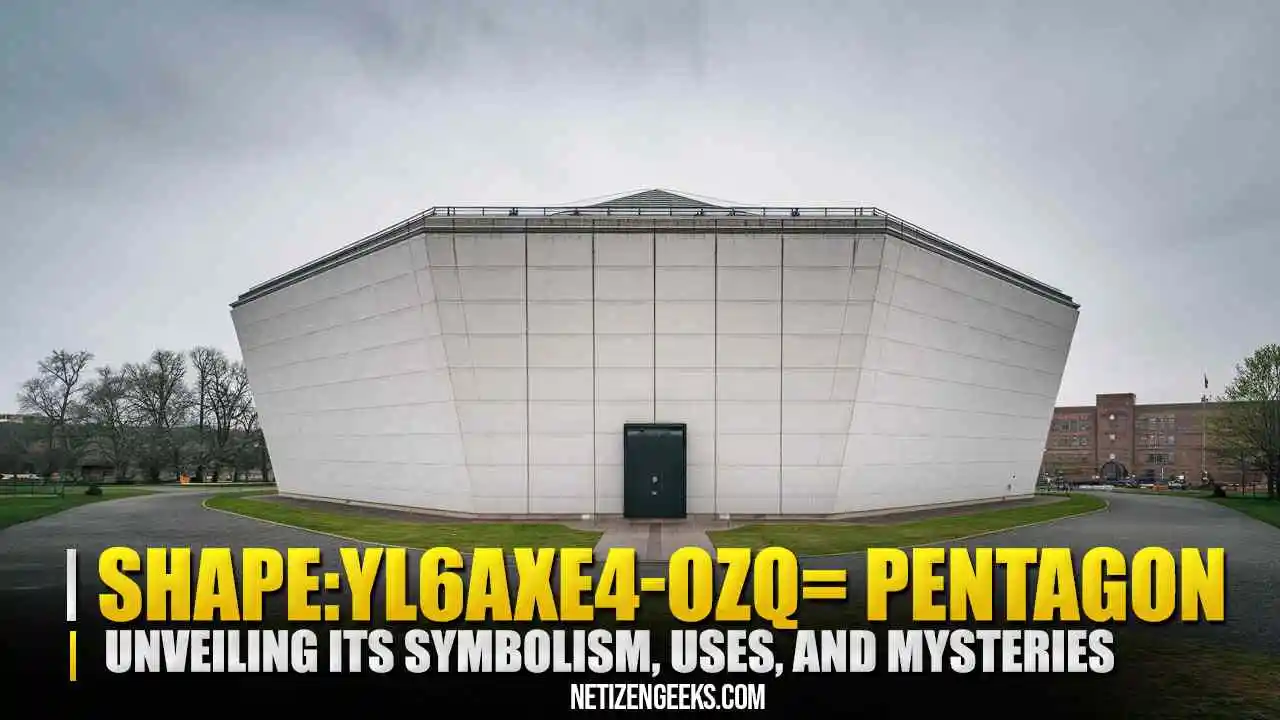Shape:yl6axe4-ozq= Pentagon: Unveiling Its Symbolism, Uses, and Mysteries
Shape:yl6axe4-ozq= Pentagon refers to the classic five-sided figure known as a pentagon. This simple yet powerful geometric shape appears across various fields, from architecture to art. Its balanced symmetry and distinct angles make it a subject of fascination in both mathematics and design.
Beyond its geometric charm, the pentagon holds symbolic importance in cultures and institutions. Think of the iconic Pentagon building in Washington, D.C., or the five-petal flowers we see in nature. The pentagon’s versatility goes far beyond its five sides.

What is Shape:yl6axe4-ozq= Pentagon?
Shape:yl6axe4-ozq= Pentagon refers to a five-sided polygon with five angles. This classic geometric shape is defined by its straight sides and distinct symmetry, making it a common subject in mathematics and architecture. Whether regular or irregular, the pentagon remains a foundational shape in geometry.
In a regular pentagon, all sides and angles are equal, creating perfect symmetry. Each interior angle in a regular pentagon measures 108 degrees, contributing to its balanced appearance. Irregular pentagons, on the other hand, feature varying side lengths and angles, making them more diverse.
The pentagon is not only a mathematical construct but also a symbol of harmony and balance. It’s found in natural forms, such as flowers and starfish, and has been incorporated into various cultural symbols, representing strength, unity, and stability.
Also Read: Drawing:4rqs7sl9p5a= sun Tips, Techniques & Mistakes to Avoid
Types of Pentagons
Pentagons come in two main types: regular and irregular. A regular pentagon has equal sides and angles, creating perfect symmetry, while an irregular pentagon features unequal sides and angles. These variations in form allow pentagons to be versatile, appearing in various fields such as mathematics, architecture, and design.
Real-World Examples of Pentagon Shapes
The pentagon is prevalent in architecture, with one of the most famous examples being the Pentagon building in Washington, D.C. Beyond structures, pentagon shapes can also be found in sports equipment, such as the black and white panels of a classic soccer ball, illustrating the shape’s functionality and visual appeal.
Pentagon in Geometry
In geometry, the Shape:yl6axe4-ozq= Pentagon plays a significant role, especially in constructing complex shapes. The regular pentagon’s interior angles, each measuring 108 degrees, form the basis for calculations in various geometric problems. It’s often used in constructing tessellations and polyhedra due to its symmetry and balance.
Pentagon in Nature
Pentagons also appear naturally, especially in biological formations. Think of a starfish, whose five arms form a natural pentagon, or the five-petal arrangement of many flowers. These natural occurrences showcase the pentagon’s symmetry, hinting at nature’s tendency toward balance and order.
Pentagon Symbolism Across Cultures
The pentagon holds deep symbolic meanings across cultures. In many traditions, it represents protection and unity, as seen in the pentagram, an ancient symbol used in various spiritual practices. Its five-sided structure often symbolizes balance, strength, and the harmonious connection between the elements or directions.
Pentagon Symbolism Across Cultures
The pentagon holds profound symbolism in various cultures, often representing balance, harmony, and unity. For example, in ancient Greece, the pentagram was associated with the goddess Venus, symbolizing love and beauty. Many spiritual traditions use the pentagon shape in rituals, showcasing its significance as a protective emblem that connects the physical and spiritual realms.
Additionally, the pentagon is a prominent symbol in modern mysticism and occult practices. It often represents the five elements earth, water, fire, air, and spirit indicating a harmonious connection to nature. Across different societies, the pentagon embodies strength and stability, illustrating humanity’s innate desire for balance in both the material and spiritual worlds.
Uses of Pentagon in Design and Architecture
In design and architecture, the pentagon is celebrated for its aesthetic appeal and functional properties. Iconic structures, like the Pentagon building in Washington, D.C., showcase its unique geometric shape. Architects frequently utilize pentagons in modern designs to create visually striking facades and layouts, emphasizing both form and function.
Beyond architecture, Shape:yl6axe4-ozq= Pentagon are prevalent in graphic design, logo creation, and urban planning. Their symmetrical nature and versatility allow for innovative designs that capture attention and convey messages effectively. From branding to city layouts, the pentagon proves to be a valuable tool in the designer’s toolkit.
Pentagons in Mathematics: The Golden Ratio
In mathematics, the Shape:yl6axe4-ozq= Pentagon is closely linked to the Golden Ratio, a mathematical principle associated with beauty and harmony. Regular pentagons possess unique properties where the ratio of a diagonal to a side length reflects this ratio, often seen in art and architecture. This intrinsic connection highlights the pentagon’s role in creating visually pleasing designs.
Additionally, the mathematical study of pentagons extends to tessellations and geometric constructions. Understanding pentagonal shapes aids in solving complex problems in both pure and applied mathematics. The beauty of the pentagon lies in its simplicity and the profound mathematical relationships it embodies.
Common Misconceptions About the Pentagon Shape
One common misconception is that all pentagons must be regular, featuring equal sides and angles. In reality, pentagons can be irregular, displaying a variety of side lengths and angles while still maintaining their five-sided identity. This flexibility allows for diverse applications in geometry and design.
Another misconception is that pentagons are primarily architectural features. While they do appear in buildings like the Pentagon, their presence is widespread, from biological forms in nature to everyday objects. Recognizing the pentagon’s versatility enriches our understanding of its significance in both art and science.
Also Read: Newssyc.in/category/dental: The Ultimate Guide to Dental Health
Overall Conclusion
Shape:yl6axe4-ozq= Pentagon shape encapsulates a wealth of meaning, extending beyond geometry into the realms of culture, design, and mathematics. Its representation of balance and harmony resonates across various disciplines, reflecting humanity’s quest for stability and connection.
As we continue to explore the pentagon’s significance, its applications in design and architecture showcase its timeless appeal. Understanding the pentagon’s role in our world enhances our appreciation for this remarkable shape and its contributions to art, nature, and science.
Frequently Asked Questions (FAQs)
The pentagon often symbolizes balance, unity, and protection, used in spiritual practices and rituals.
Architects use pentagons for their aesthetic appeal and structural efficiency, as seen in iconic buildings like the Pentagon.
The pentagon reflects the Golden Ratio in the ratio of its diagonals to its sides, contributing to its aesthetic quality.
No, pentagons can be irregular, having unequal sides and angles while still being classified as five-sided polygons.
Pentagons are found in various natural forms, such as starfish and certain flowers, illustrating their significance beyond geometry.







